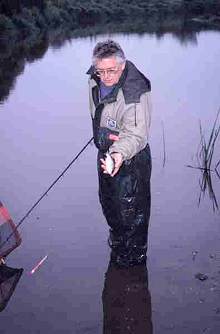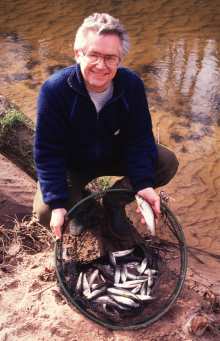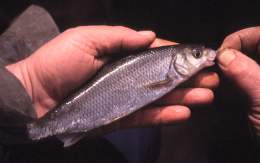|
|
| |
Dave will use heavy gear to fish for big barbel one day and a pole on ultra-light tackle the next to bag up on roach.
The emphasis on this new series is how to enjoy your fishing no matter where you’re fishing or what you’re fishing for.
Bars and Darts
No, nothing to do with pub’s I’m afraid, although relaxing after a fishing session in nice old pub with a pint, chatting in the company of fellow anglers and perhaps having a game of darts, would be an ideal end to a day’s fishing.
The bars and darts I’m referring to produce lightening fast bites and, if you manage to hook them, they flash their silver flanks and fight with tenacity despite their rather meagre average size.
|
|
| |
I am of course talking about roach and dace. These fish have been referred to in days gone by with the affectionate nicknames of the ‘silver bar’ (the roach) and the ‘silver dart’ (the dace). The roach is the more widespread and common of the two species, being generally more hardy than it’s cousin, but specimens of either are few in our rivers these days. The dace especially has suffered from loss of habitat through development and water extraction. The fast clean streams in which they thrive are sadly diminishing.
However, if you know a good venue for these species, they can produce an entertaining day’s fishing even in the colder months.
At this time of year in the rivers both species will have shoaled up tightly and moved into their generally deeper water winter habitats. And it is now, if you can locate the shoals and if the weather is kind to you, that good sport can be had. There is also the possibility of a decent specimen.
Location is the key and local knowledge of the river is a definite advantage. Dace in particular drop out of the faster, shallower water and move to the deeper, steadier glides. Here they feed less, conserve their energy and keep out of those winter floods. So if you look for the deep areas generally downstream of where dace were caught in summer, you could find a dense shoal.
Roach shoals do much the same thing, generally looking for deeper water and shelter. Deep areas around bridges are often particularly good places to find them.
And once located there is no better way of catching either species than by float-fishing for them. If you want a specimen you will probably be better off with a soft action quiver and bread flake, but for a net full of fish and a good few hours of fun on a cold day, fish for them on the float. Both species are a joy to catch on the waggler when you can get them queuing up for loose-fed maggots and both are equally synonymous with stickfloat fishing.
Of the two methods, fishing the waggler is probably easier to master than trotting a stickfloat, although waggler fishing a big river, especially one with a bit of pace like the Severn for instance, which is famous for it’s large shoals of roach, is a bit of an art. But it is an art that most people can learn, so don’t be put off.
It is preferable though to fish a stickfloat at this time of year, especially for roach as they often like a bait held back firmly so it is going much slower than the current. This can only be achieved with a stick. But if the fish are more than two rod lengths out you have little choice but to compromise and use the waggler and try and persuade them to take your bait at the speed of the current.
And persuading them to feed is one of probably three key items that you have to take into account, along with presentation and rhythm, when float fishing a river for roach or dace whether on a waggler or a stickfloat.
What time of day to fish is important, with the afternoon of grey winter days often being better than other times. And then patient and accurate feeding is a must because at this time of year it can take a while to get the shoal feeding properly, maybe an hour or more of constantly trickling feed into the swim.
|
|
| |
Little and often is a phrase that has been written many times but it is so essential for this type of fishing that it has to be repeated. Maggot is by far the best bait for this method and trickling them in, maybe as few as six to ten a cast, is vital. Often it is not the quantity of feed but the continuity that gets roach in particular feeding well. Taking into account the temperature and the number of fish you believe you have in front of you, adjust the amount of feed going in but, whatever the quantity, keep it trickling through on the same line every cast and eventually the fish will be queuing up. It’s also worth considering adding a flavouring to your maggots, maybe one of the commercial ones like Archie Braddock’s spicy offerings, or good old turmeric out of the food cupboard.
Work out where your catching zone is going to be, ideally just downstream of you and make sure the bait is going in far enough upstream to be dropping through this area with your hook bait. But beware, the shoal can move up the feed line, so don’t feed so far up that the fish move past you!
The second of the three key items is presentation. For the waggler, choosing the size of waggler in the first place is not always easy, but the simple rule is it needs to be heavy enough to cast a couple of metres past where you want to fish and still allow you to feather the cast. Don’t struggle to reach the distance that you want to fish at by using too light a float particularly on a windy day. On rivers a 3AAA or even 4AAA straight peacock waggler is the norm. Shot the float with at least 75%, and up to 90%, of the bulk around the base of the float, and then ‘shirt button’ dropper shot below. Use number 4, 6 or 8 shot, or combinations of, depending on how quickly you want to get the bait dropping in conjunction with the pace of the water.
It is with stickfloat fishing that most people struggle with float choice, however. Here the general rule is equally simple. It’s a correlation of BB shot to depth. Very basically it is one BB shot for each foot of depth of water. In other words, for a six foot deep swim use a 6BB stick float. It is often best to use a lot of small shot rather than fewer of the bigger sizes. This allows you scope to vary the shotting pattern. A bulk pattern to get the bait down fast if the fish are on the bottom can be achieved by sliding the shot together. If the fish move up in the water later on the shot can be spread to make an ‘on the drop’ pattern. To be able to hold the float back hard, use a float with a pronounced shoulder that won’t ride out of the water.
|
|
| |
The third key item identified above was rhythm. You need to get into a rhythm of feeding and casting, feeding then casting and always on the same spots. To get into that rhythm you need to be organised. Have your bait and catapult easily to hand. A bait apron is best of all for this. Stand up to fish if you can (but stay off the skyline, particularly in clear water conditions) and set up two rod rests at waist height so you can set the rod down while you feed. Whether using a stick or a waggler cast slightly downstream from where you are fishing, feathering the cast to allow the rig to land in a straight line and not a tangled heap. Then immediately mend the line behind the float to prevent a bow forming and allow it to run through.
With the stick of course you can vary the pace at which the float goes through. As I mentioned earlier, roach in particular often like the bait to be slowed down when the water temperature is low. Holding a stick back hard can get bites when running with the pace of the current fails to produce any. Dace are notoriously fast biters and can be really difficult to hit. By holding back the float and having more direct contact between rod tip and bait I have found dace can often hook themselves. Another tip with dace, on either method, is to not use a barbless hook. They twist and turn so fervently that they often escape from a barbless and I find a small barbed hook far better. Another tip to reduce the number of lost dace is to ensure they are well beaten before lifting them from the water. If they are still fighting as you lift them clear of the water, they have the annoying habit of dropping off before you grab hold of them.
|
|
| |
By following some of the suggestions above and if the fish are willing, you can get roach and dace competing for your bait and have your float disappearing with regularity even in December and January. It can be hard work and at times frustrating when they just won’t have it, or when they start to feed and then mysteriously disappear again. But get them going and there is no greater fun on a winter’s day than feeling the jag-jag fight of a hooked roach or having a good dace twisting and turning in an effort to escape.
Watch out for pike though, because wherever you get shoaled silver fish feeding well the pike won’t be far away, attracted to the underwater flashing of silver flanks and they have a nasty habit of stealing a hooked fish and upsetting the shoal. Mind you, getting the offenders out of your swim is also great fun, but that’s another story.
Oh and don’t forget to sample the bars and darts at the pub afterwards along with a good pint of beer and log fire. It’s a perfect end to a pleasurable day fishing.















